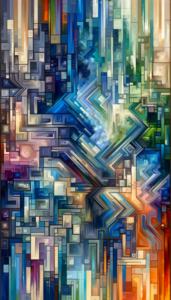Cover Image and AI
A brief note on the book cover
Talking about academic integrity, lately, takes a swift turn to artificial intelligence (AI) and its technological prowess to produce texts that mimic ways of expressing language, creative arts, musical scores and so on. One of the objectives of this educational resource is to substantiate the value of learning or an educative approach. Advancements in generative AI-based tools are an example of learning, of technical expertise meeting creative potential to address tasks that are frequently observed in academia and the professions. The case of essay writing, for instance, has many writing instructors rethinking objectives, outcomes, and assessment design for the assignment type. However, what is an accepted and standard structure of an essay versus what constitutes good writing are different parameters. The best AI tools in the market can present material to pass standardized tests, but they don’t present appealing arguments, culturally nuanced or delicate observations. Whether such nuances can be learnt in academic classrooms or not is a research worthy endeavour. This resource posits that practicing skills can make one better users and more importantly, better practitioners because one learns how to change the narrative to a different version. Generative AI-based tools will always catch up to the new version, but one can argue that they will be learning and not leading the process.
To highlight this distinction between learning and leading, the book cover played an important  role. With support from the project assistant, several images using free versions of a few different generative AI tools were generated and these were all acceptable cover-worthy images. Here are a couple of examples.
role. With support from the project assistant, several images using free versions of a few different generative AI tools were generated and these were all acceptable cover-worthy images. Here are a couple of examples.  But we chose differently. Not only was the cover an avenue to showcase the educative approach but also to “capture authentic moments” as the cover artist states below, appreciate the photographer’s intent, angle and vision. Layering the original work with the OER’s title and other factual details was accomplished by the cover designer, Jiayi (Nancy) Lu who planned the details and completed a task that extended her educational pursuits. Thus, there are many reasons to appreciate and create more generative AI based tools. There are many more reasons to learn the discipline so that the tools are used effectively to push the borders of innovative learning.
But we chose differently. Not only was the cover an avenue to showcase the educative approach but also to “capture authentic moments” as the cover artist states below, appreciate the photographer’s intent, angle and vision. Layering the original work with the OER’s title and other factual details was accomplished by the cover designer, Jiayi (Nancy) Lu who planned the details and completed a task that extended her educational pursuits. Thus, there are many reasons to appreciate and create more generative AI based tools. There are many more reasons to learn the discipline so that the tools are used effectively to push the borders of innovative learning.
Artist’s statement
I’m Kiki Omipidan, a street photographer hailing from Calgary, Alberta. My journey into photography took an intriguing turn about two years ago when I became enamoured with the timeless aesthetic of film photography, particularly vintage film cameras. This fascination spurred me to delve deeper into photography, seeking to expand my knowledge and refine my skills. Along the way, I’ve embraced the role of an observer, training myself to notice the often overlooked details of everyday life. Through my lens, I strive to capture authentic moments that reflect the essence of ordinary experiences. And I’m grateful to have had the opportunity to see some of my work published in Docu Magazine, a respected street and documentary photography print company headquartered in Finland. When I’m not behind the camera, you can find me pursuing my studies in philosophy at UBC Okanagan.
Media Attributions
- People Going To University in Abstract © Kiki Omipidan adapted by Jiayi (Nancy) Lu

